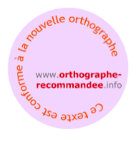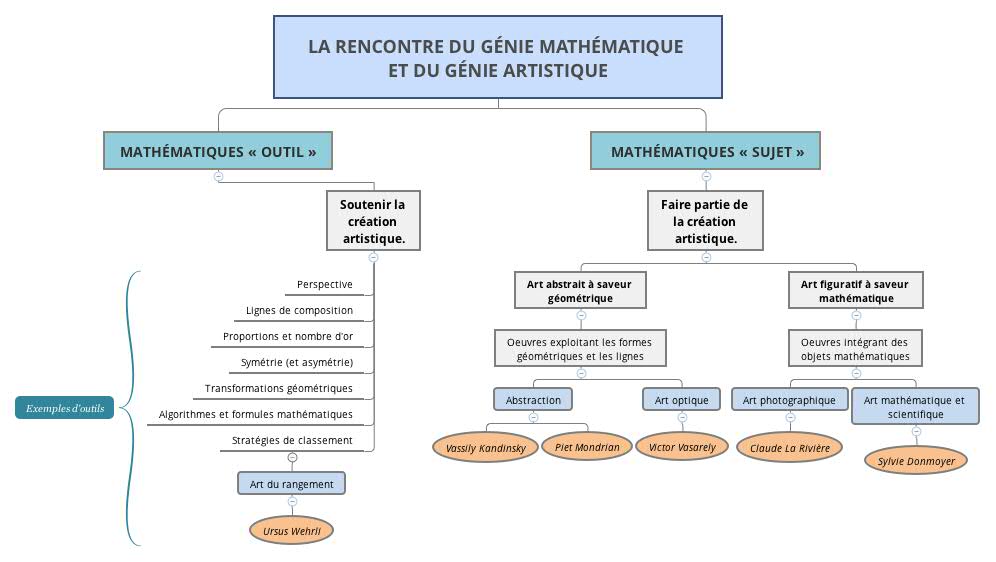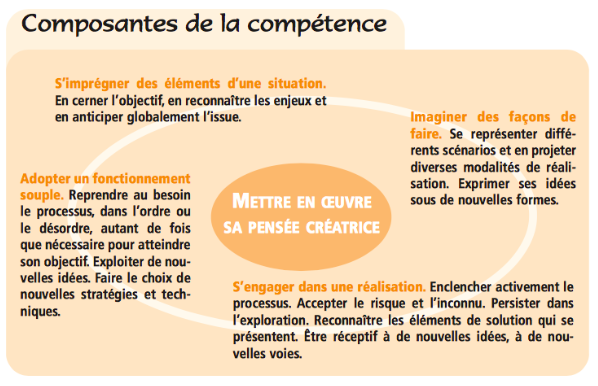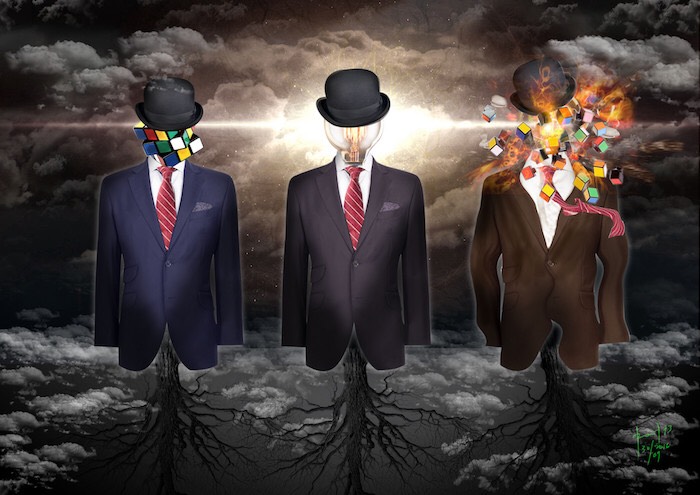Existe-t-il des liens entre les mathématiques et les arts plastiques? Ces deux disciplines en apparence opposées possèdent plusieurs points communs extrêmement intéressants.
par Stéphanie de Champlain et Jennifer Poirier
(Source de l’image de présentation du dossier, page consultée le 24 avril 2017.)
Sous un angle artistique
Claude La Rivière
(2017)
Œuvre inédite de l’artiste pour ce dossier

En italique : intentions et démarches créatives à vivre en classe
SOMMAIRE DU DOSSIER
- Les liens qui unissent les mathématiques et les arts plastiques
- Vue d’ensemble
- Proposition
LES MATHÉMATIQUES COMME OUTIL POUR SOUTENIR LA CRÉATION
- Des outils mathématiques très utiles
- La perspective
- Les lignes de composition
- Les proportions et le nombre d’or
- La symétrie et l’asymétrie
- Les transformations géométriques
- Les algorithmes et les formules mathématiques
- Les stratégies de classement
- Exemples de pistes d’exploration
- Art du rangement
LES MATHÉMATIQUES COMME SUJET DE CRÉATION
- L’art abstrait à saveur géométrique
- Abstraction : Hommage à Kandinsky
- Abstraction : Le cercle sous toutes ses formes
- Art optique (Optical art) : Hommage à Vasarely
- L’art figuratif à saveur mathématique
- Photographie mathématique
- Le chiffrier
- Le récit à saveur mathématique
- Les illustrations exploitant les formes géométriques
- La fin d’un voyage… Le début de la création
- Remerciements
- Note sur les droits d’auteur
LORSQUE LE GÉNIE MATHÉMATIQUE RENCONTRE LE GÉNIE ARTISTIQUE…
Les meilleurs travaux des mathématiciens sont de l’art, un art très perfectionné, défiant les rêves les plus secrets de l’imagination, clairs et limpides. Le génie mathématique et le génie artistique se touchent l’un l’autre.
Gösta Mittag-Leffler
Nous vous invitons à plonger au cœur de cette rencontre créative et à profiter des liens qui unissent ces deux univers d’une incroyable richesse.
LES LIENS QUI UNISSENT LES MATHÉMATIQUES
ET LES ARTS PLASTIQUES
Même si ces deux disciplines sont en apparence opposées, elles possèdent plusieurs points communs extrêmement intéressants.
L’intention… Mieux comprendre le monde qui nous entoure et lui donner un sens.
Le processus… Mettre en œuvre un processus créatif pour donner vie à une réalisation artistique originale ou à une solution mathématique inédite.
Le langage… Explorer le langage des formes, des lignes, des volumes et de l’espace…
L’omniprésence... Observer la présence des mathématiques et des arts dans notre environnement.
Pour mieux cerner la relation qui existe entre les mathématiques et les arts plastiques, nous nous sommes inspirées d’une conférence de Denise Demaret-Pranville, professeur de mathématique et artiste plasticienne :
Art et mathématiques
Une vision artistique ou scientifique du monde :
opposition ou complémentarité?
8 décembre 2014
Voici un extrait de cette conférence :
| « Il y a deux façons différentes de rencontrer les mathématiques dans le domaine de l’art, soit comme un outil aidant à la création d’une œuvre, comme, par exemple, avec l’utilisation de la perspective, soit, au contraire, lorsque l’artiste choisit de prendre des objets mathématiques comme sujet, ce qui est très présent dans l’art géométrique ou dans l’art fractal. On peut dire que, dans le premier cas, les mathématiques constituent un outil au service des artistes, et que, dans le second cas, les mathématiques deviennent un sujet de l’art. » |
Les mathématiques et les arts sont donc deux disciplines à explorer en complémentarité.
VUE D’ENSEMBLE
Pour faciliter votre navigation à travers ce dossier, nous avons conçu un organisateur graphique inspiré des propos de Mme Demaret-Pranville. Mentionnons que les catégories suggérées ne sont pas exhaustives et hermétiques. N’hésitez pas à imaginer d’autres liens ou d’autres exemples.
 Cliquer sur l’organisateur graphique pour l’agrandir.
Cliquer sur l’organisateur graphique pour l’agrandir.
Note
Dans ce dossier, nous utilisons le terme « objets mathématiques » dans un sens élargi pour permettre aux élèves de différents âges de vivre des expériences à leur portée. Cette expression désigne donc des objets mathématiques comme les polyèdres, mais également des objets concrets liés aux mathématiques comme les instruments de mesure ou certains jeux (cartes, dominos, dés).
(Voir la liste des objets qui représentent les mathématiques dans la section intitulée L’ART FIGURATIF À SAVEUR MATHÉMATIQUE.)
PROPOSITION
Pour favoriser l’établissement de ponts entre les mathématiques et les arts, nous vous proposons quelques intentions créatives qui se concrétisent à travers une courte démarche de création « artistico-mathématique » en quatre phases :
| Inspiration | Réalisation | Retour | Diffusion |
| Découvrir un artiste et sa couleur mathématique pour s’inspirer. | S’engager dans la réalisation d’une œuvre. Vivre un processus créatif en s’appuyant sur ses ressources artistiques et mathématiques. |
Faire un retour sur les œuvres créées d’un point de vue artistique et mathématique. | Partager les œuvres à saveur mathématique. |
Vous reconnaitrez dans cette démarche des éléments inspirés de la dynamique de création du domaine des arts et de la compétence « Mettre en œuvre sa pensée créatrice ».
 Infographie réalisée par Andrée-Caroline Boucher,
Infographie réalisée par Andrée-Caroline Boucher,
personne-ressource au service national du RÉCIT des arts
Inspirée du Programme de formation de l’école québécoise (secondaire)
Domaine des arts
Mettre en œuvre sa pensée créatrice

Programme de formation de l’école québécoise (primaire)
Compétences transversales
N’hésitez pas à modifier et à enrichir ces idées selon vos intentions pédagogiques et la clientèle visée.
Voici quelques variantes possibles :
- Réaliser les œuvres sur un support papier et exploiter le numérique pour s’inspirer, apprécier ou diffuser les créations.
- Vivre la démarche proposée pour découvrir un autre artiste ou un autre mouvement artistique.
- Choisir une application plus ou moins complexe selon l’âge des élèves.
- Mettre davantage l’accent sur le volet mathématique ou le volet artistique.
BONNE EXPLORATION!
Note sur les applications
Certaines applications proposées affichent de la publicité ou exigent la création d’un compte (compte personnel ou compte de classe selon l’âge des élèves). Nous les avons tout de même retenues puisqu’elles sont gratuites et intuitives.
Lorsque les applications présentent des bannières publicitaires ou des fenêtres « popup », il est possible de les bloquer en utilisant un outil gratuit comme AdBlock.
Note sur les illustrations
Les illustrations qui ne comportent pas le nom d’un artiste ont été réalisées par les auteures de ce dossier. Merci de mentionner la source si vous souhaitez les réutiliser.
—
SUITE : LES MATHÉMATIQUES COMME OUTIL POUR SOUTENIR LA CRÉATION







